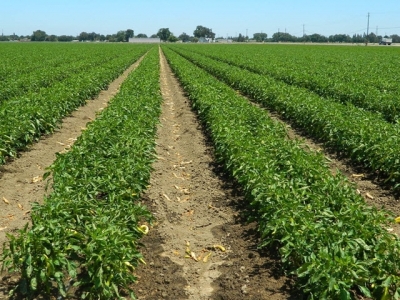Understanding nitrogen fertilisation in vegetables – part 1

Of all the plant nutrients, nitrogen has the greatest influence on the success of any crop. While a shortage of any element will be a limiting factor, its effect on crop performance will be related to its function, importance and shortage.
These peppers held nitrogen due to a good humus content, despite heavy rainfall exceeding 300mm/month. No nitrogen had to be applied.
Nevertheless, nitrogen is the most difficult plant nutrient to manage due to its fleeting nature. The other elements in a soil analysis are expressed at stable levels that can be relied upon when formulating a fertiliser programme. No so nitrogen, which can be here today and gone tomorrow. Nitrogen is so volatile that it doesn’t even reflect in a regular soil analysis. There are so many misconceptions about its use in vegetable production that it justifies some explanation.
What happens in the soil
Commercial nitrogen fertiliser comes in two basic forms – ammonia and nitrate. Both are extracted from the air we breathe, which contains nearly 80% gaseous nitrogen. This converts to commercial fertiliser at a hefty energy input that breaks the bond of the two nitrogen molecules and attaches them to other elements used to make fertiliser. The ammonia fraction is a cation with a positive electrical charge, while nitrate is an anion with a negative charge.
In the soil, the positively charged ammonia attracts and binds to negatively charged soil colloids (clay particles). It can also bind to humus, which is predominantly negatively charged but does have some positively charged sites that attract anions. This extremely important quality will be clarified later. This ammonia remains secure against leaching and is a useful, safe reserve of nitrogen in the soil. It will stay in this form until converted to the nitrate form by bacteria, thus changing it from a positively charged cation to a negatively charged anion.
It’s now repelled by the negatively charged clay particles and remains in the soil solution. Here it’s freely available for uptake by plants, but is also easily leached as it moves with the soil moisture. One heavy rain or over-irrigation can leach it all out in one go. Having nitrogen in the soil in these two forms provides the benefit of readily available nitrate with the risk of leaching, and the ammonia fraction that can’t leach but continually feeds the soil solution with bacteria-converted nitrate.
Determining nitrogen loss
A major problem every farmer occasionally faces is determining how much of the total nitrogen has been lost to leaching after a steady, heavy rain. The question arises after applying a fertiliser in the ammonium form such as ammonium sulphate or urea – how much was converted to nitrate before the downpour? If recently applied, we can be sure it’s all securely attached to the soil colloids and still in place.
If it rained six weeks after application, it would be uncertain how much remains, as the soil bacterial content and temperature also play a role in the conversion rate of ammonium to nitrate. We find that when the crop starts displaying a deficiency, a yield loss will be certain. Practical steps to avoid this will be covered in a follow-up article. A healthy humus content is a beneficial safeguard. Humus has positively charged sites that attract negatively charged nitrate and prevent leaching while it’s available to the plant.
In my soil (3,24% humus content), I have no nitrogen leaching, not even with 200mm rain over a few days. The percentage of the exchange capacity of humus that attracts anions is unknown, although significant and a very important incentive to increase organic levels in our soil, but it’s certainly considerably below the cation exchange capacity.
Có thể bạn quan tâm
Phần mềm

Phối trộn thức ăn chăn nuôi

Pha dung dịch thủy canh

Định mức cho tôm ăn

Phối trộn phân bón NPK

Xác định tỷ lệ tôm sống

Chuyển đổi đơn vị phân bón

Xác định công suất sục khí

Chuyển đổi đơn vị tôm

Tính diện tích nhà kính

Tính thể tích ao hồ



 Understanding nitrogen fertilisation in vegetables – part 3
Understanding nitrogen fertilisation in vegetables – part 3  Cropped: Tips for Growing Hops
Cropped: Tips for Growing Hops